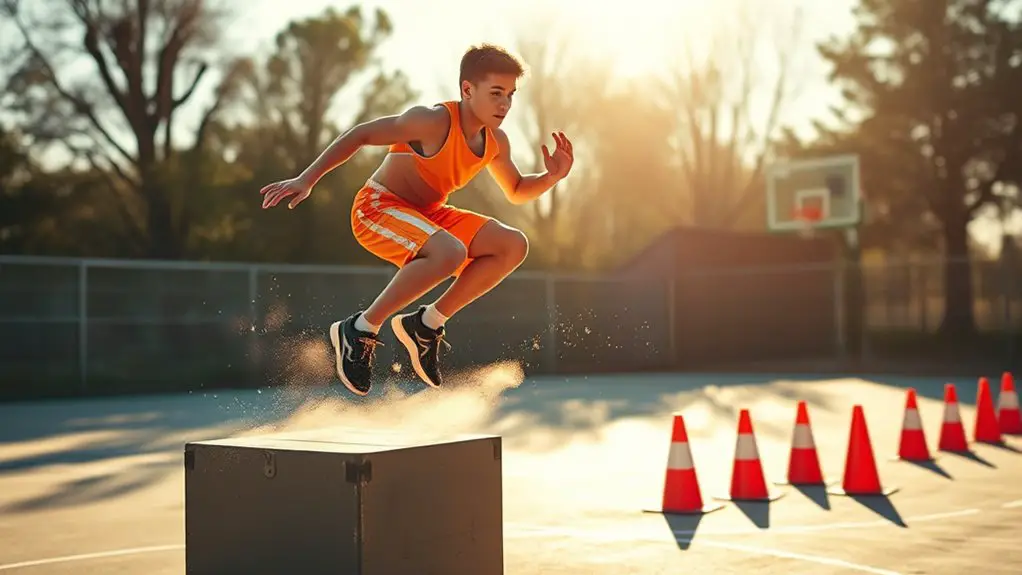Sled training builds explosive acceleration by targeting fast-twitch muscle fibers essential for quick bursts of speed. As you engage multiple muscle groups, you'll enhance your power, coordination, and balance. The sled mimics sprinting mechanics, helping you develop a natural sprinting posture. By incorporating resistance, it also boosts core stability and overall athletic performance while reducing the risk of injury. If you're interested in maximizing your sled training, you'll find even more tips and techniques worth exploring.
Understanding Explosive Acceleration
Explosive acceleration is like a rocket launch—it's all about that powerful burst of speed. When you think of freedom, you probably envision breaking barriers and pushing limits, and that's exactly what explosive acceleration does. It's the instant you release your energy, propelling yourself forward with ferocity. This type of acceleration isn't just about speed; it's about harnessing your inner strength and responding to the call of freedom in movement.
Imagine sprinting away from constraints, feeling the wind against your skin as you gain momentum. Every step is a declaration of independence, a demonstration of your power. To achieve this, you need to tap into fast-twitch muscle fibers, the ones that ignite your potential. It's about mastering the art of rapid response, turning the ground beneath you into a launchpad for your ambitions. Additionally, incorporating plyometric exercises into your routine can significantly enhance your explosive acceleration. Embrace the thrill of explosive acceleration, and you'll find yourself soaring toward your goals.
The Mechanics of Sled Training
While many training methods focus on speed and agility, sled training stands out as a powerful tool for enhancing explosive acceleration. When you harness the sled's resistance, you engage multiple muscle groups, particularly in your legs and core. This builds strength while mimicking the mechanics of sprinting.
As you push or pull the sled, you'll notice how your body shifts into a forward lean, promoting natural sprinting posture. Your arms work in tandem with your legs, reinforcing coordination and rhythm. The resistance helps you develop fast-twitch muscle fibers, which are essential for those quick bursts of speed. Additionally, sled training emphasizes core stability and strength, which is crucial for overall athletic performance.
Benefits of Sled Training for Athletes
Sled training offers numerous benefits for athletes looking to enhance their performance. First and foremost, it builds explosive strength, essential for quick acceleration in any sport. As you push or pull the sled, you're engaging multiple muscle groups, promoting overall power and balance. You'll also boost your speed and agility, as sled training mimics the movements required during competition.
Another great aspect is the reduced risk of injury. By strengthening your muscles and joints through controlled resistance, you're less likely to suffer from strains or sprains. Plus, sled training is versatile; you can easily adjust the weight to suit your current fitness level, ensuring you're always challenged.
Finally, this type of training improves your conditioning. By incorporating sprints and intervals, you'll elevate your heart rate and enhance endurance, giving you that extra edge when it counts. Additionally, sled training supports muscular endurance by allowing athletes to push their limits effectively. Embrace sled training, and watch as your performance soars!
Incorporating Sled Training Into Your Routine
To effectively incorporate sled training into your routine, it's vital to start with a clear plan that aligns with your fitness goals. Sled training can be an exhilarating way to boost your performance, but it's important to integrate it thoughtfully. Here are some tips to help you along the way:Incorporate sled training thoughtfully by setting clear goals and planning your sessions for optimal performance enhancement.
- Choose the right sled: Select a sled that suits your training needs and environment.
- Set specific goals: Determine what you want to achieve, whether it's speed, strength, or endurance.
- Schedule your sessions: Plan sled workouts into your weekly routine, balancing them with other training.
- Track your progress: Keep a log of your sled training sessions to monitor improvements and adjust as needed. Additionally, incorporating sled training can enhance your overall athletic performance, making it a valuable addition to your regimen.
Safety Tips for Effective Sled Training
Engaging in sled training can be incredibly rewarding, but ensuring your safety should always come first. Before you hit the track, make sure you're wearing the right gear—think sturdy shoes, knee pads, and a supportive belt. Always warm up to prevent injuries; dynamic stretches can get your muscles ready for action.
When setting up your sled, choose a flat, open space free from obstacles. Start with lighter weights to master your form, then gradually increase intensity as you gain confidence. Keep an eye on your surroundings, and if you're training with others, maintain a safe distance to avoid collisions.
Stay hydrated and take breaks as needed; pushing too hard can lead to fatigue and injuries. Finally, listen to your body. If something doesn't feel right, don't hesitate to stop and reassess. Prioritizing safety lets you enjoy sled training and release your potential. Remember, rest days are essential for recovery, allowing your muscles time to rebuild and strengthen after intense sled workouts.
Frequently Asked Questions
How Often Should I Do Sled Training for Optimal Results?
To get ideal results from sled training, aim for two to three sessions per week. This frequency allows your body to adapt while still challenging your muscles, promoting strength and explosive power without overtraining.
Can Sled Training Help With Injury Recovery?
They say, "What doesn't kill you makes you stronger." Sled training can aid injury recovery by improving muscle strength and stability, helping you regain confidence and mobility, allowing you to reclaim your freedom and push past limitations.
What Type of Sled Is Best for Beginners?
For beginners, a lightweight, adjustable sled's best. It lets you gradually increase resistance as you build strength and confidence. Look for one with a comfortable handle, ensuring you enjoy every push and pull without strain.
Is Sled Training Suitable for All Sports?
Sled training's versatile, making it suitable for various sports. Whether you're into football, track, or soccer, it enhances strength and speed. Just tailor the intensity to fit your specific sport and goals for best results.
How Do I Track My Progress With Sled Training?
To track your sled training progress, jot down jumps, speeds, and sled weights. Measuring milestones regularly keeps your motivation moving, allowing you to savor the sweet satisfaction of steady improvements while pursuing your performance potential.




